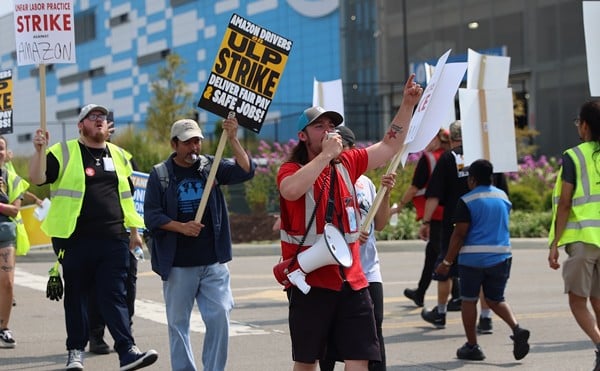Hundreds of students missed class Oct. 23 to help launch what some are calling "the new civil rights movement."
Not content to relegate issues of racial justice to the CAN (Community Action Now, a committee formed six months ago by the mayor of Cincinnati), students from Taft, Hughes, Purcell-Marian and Walnut Hills high schools and the School for the Creative and Performing Arts braved a pelting rain to demonstrate support for affirmative action in higher education.
Joining the march from the University of Cincinnati to Fountain Square were students from universities in Michigan, Ohio, Kentucky and Tennessee.
The Coalition to Defend Affirmative Action and Integration and Fight for Equality By Any Means Necessary (BAMN), which organized the rally, is composed mostly of students. Tanya Troy, a coordinator for BAMN, estimated the march at about 1,000 people.
BAMN formed in response to a 1995 vote by the California Board of Regents banning affirmative action, the catalyst for many of the ensuing affirmative action lawsuits across the country.
"Am I my brother's keeper?" a BAMN organizer asked the crowd on UC's lawn.
"Yes I am!" was the overwhelming response.
The procession had barely left campus when it began to rain. Students filed up Calhoun Street and made their way slowly down Vine Street as people in cars stared or blared their horns in support.
At one point, flashing police lights brought a hush to the front of the line, then elicited cheers as the cruiser blocked traffic so the marchers could pass with their line unbroken.
Students, some as young as 14, marched, sang, danced and chanted their way down to Fountain Square.
The occasion for the rally was a hearing before the U.S. Sixth Circuit Court of Appeals, originally scheduled Oct. 23. The court, which meets in Cincinnati, will rule on two cases from Michigan. A federal district court has upheld the use of affirmative action in undergraduate programs at the university, but disallowed them in the university's law school.
The disparity in the two rulings by the lower court reflects the mixed feelings many people have about the issue. Affirmative action refers to measures to promote opportunity to groups that have historically been disadvantaged or discriminated against, such as women, ethnic minorities and the poor.
Most of these programs developed from the 1950s through the 1970s as the government tried to integrate schools and the workforce and to equalize opportunity for those who are not white and male. In the past decade, many courts have deliberated whether affirmative action is just, whether it works and whether it is still needed.
Opponents of affirmative action say it allows unqualified applicants to steal positions in schools or jobs from more qualified applicants; offers special privileges to certain groups, a form of reverse discrimination; and demeans its beneficiaries, implying they are unqualified for their position.
Those arguments clash with the facts, according to Brandon Hill, president of the Northern Kentucky University Chapter of Students Together Against Racism.
"There are always pre-requisite qualities to be considered for a position of any sort," Hill says. "So the idea of being unqualified or undeserving is ridiculous. Affirmative action takes into account our racial disparities, America's historically racist background, institutions of the United States that are racist. We are not looking for special privileges; we're looking for equal opportunities. The idea that you got your position because you're black or a woman (doesn't take into account) that you had to work twice as hard to get there in the first place. The goal of affirmative action is to create a world where there will be no need for affirmative action, but we are far from that."
They BAMN protesters' opening chant was, "We won't take re-segregation! Equal quality education!" Even though many of the protesters are too young to have attended any college classes, they believe their chance of attending the school of their choice is in jeopardy.
The court postponed the hearing to Dec. 6 so all nine federal appeals judges could participate. That is a significant development, according to Miranda Massie, lead counsel for the student interveners in the Michigan Law School case.
"It communicates the tremendous historic importance of the case, because it is very rare to have all the judges rule," Massie says. "The Sixth Circuit has recognized and expressed that by reviewing the case as a whole."
The judges' decision will be binding in Ohio, Kentucky, Michigan and Tennessee. Only the U.S. Supreme Court will have the power to reverse it.
The Rev. Jesse Jackson, who had been scheduled to speak at the Oct. 23 rally, canceled when the court changed the hearing date. Jackson has agreed to speak Dec. 6 in Cincinnati, when BAMN plans another rally. ©





